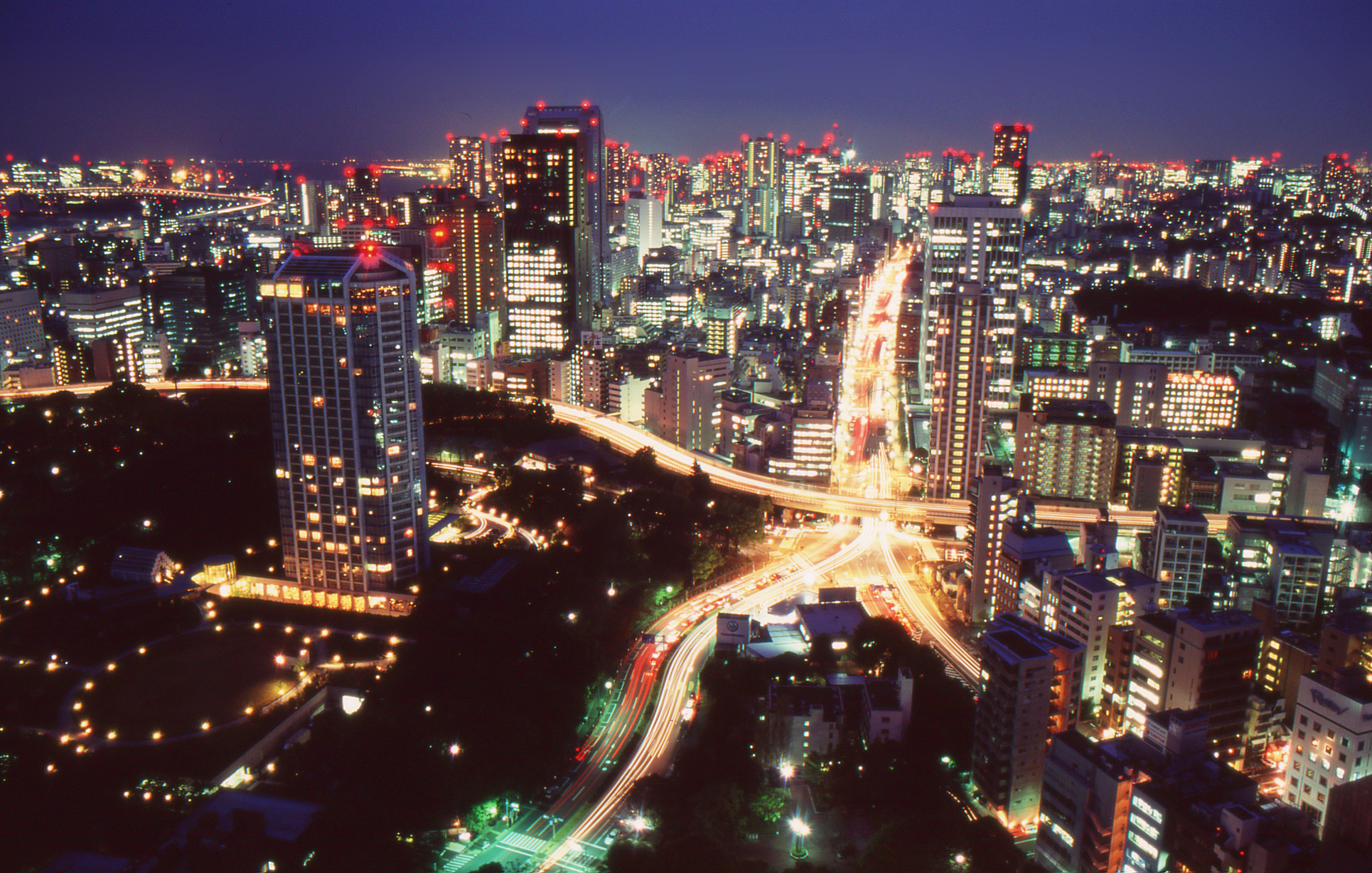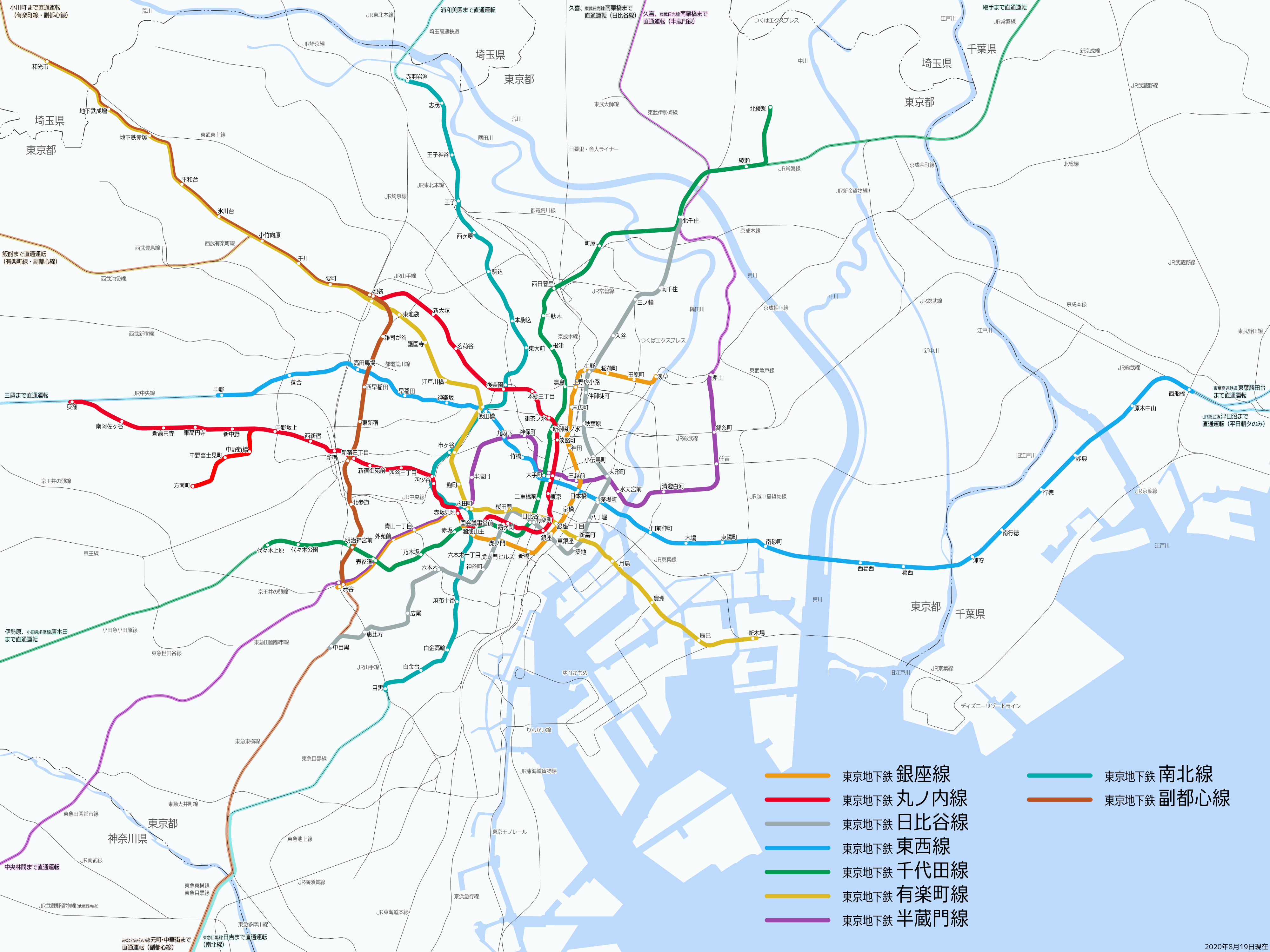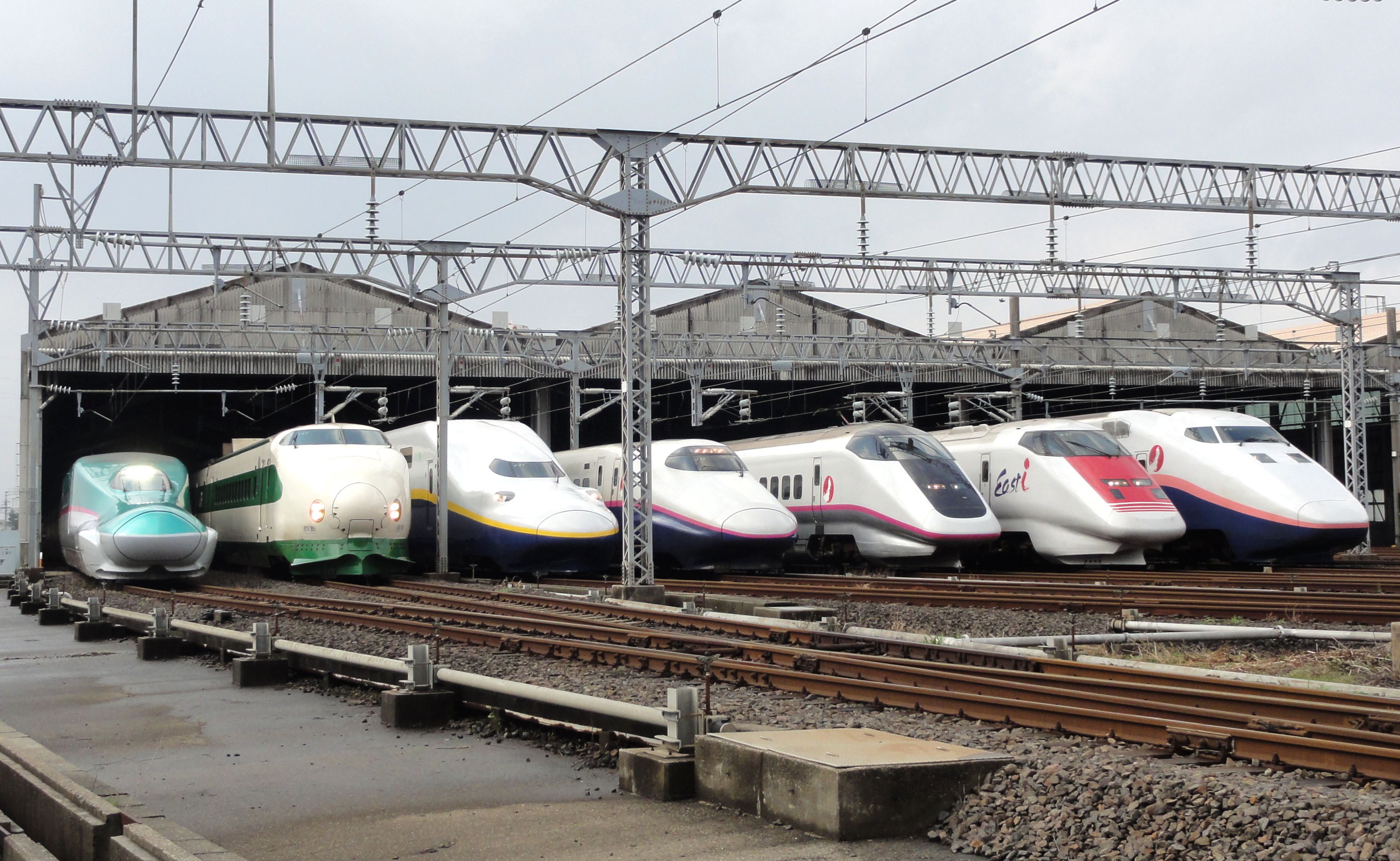|
Transport In Tokyo
The transport network in Greater Tokyo includes public and private rail and highway networks; airports for international, domestic, and general aviation; buses; motorcycle delivery services, walking, bicycling, and commercial shipping. While the nexus is in the central part of Tokyo, every part of the Greater Tokyo Area has rail or road transport services. There are also a number of ports offering sea and air transport to the general public. Public transport within Greater Tokyo is dominated by the world's most extensive urban rail network (as of May 2014, the article Tokyo rail list lists 158 lines, 48 operators, 4,714.5 km of operational track and 2,210 stations lthough stations are recounted for each operator of suburban trains and subways run by a variety of operators, with buses, trams, monorails, and other modes supporting the railway lines. The above figures do not include any Shinkansen services. However, because each operator manages only its own network, the syst ... [...More Info...] [...Related Items...] OR: [Wikipedia] [Google] [Baidu] |
Tokyo Metro
The Tokyo Metro () is a major rapid transit system in Tokyo, Japan, operated by the #Organization, Tokyo Metro Co. With an average daily ridership of 6.52 million passengers (as of 2023), the Tokyo Metro is the larger of the Tokyo subway, two subway operators in the city, the other being the Toei Subway, with 2.85 million average daily rides. Organization Tokyo Metro is operated by , a joint-stock company jointly owned by the Government of Japan and the Tokyo Metropolitan Government. The company, founded as a part of then-Prime Minister Junichiro Koizumi's policy of converting statutory corporations into Joint-stock company, joint-stock companies, replaced the , commonly known as Eidan or TRTA, on April 1, 2004. TRTA was administered by the Ministry of Land, Infrastructure and Transport (Japan), Ministry of Land, Infrastructure and Transport, and jointly funded by the national and metropolitan governments. It was formed in 1941 as a part-nationalization of the Tokyo Undergrou ... [...More Info...] [...Related Items...] OR: [Wikipedia] [Google] [Baidu] |
Keikyu Corporation
(), also known as or, more recently, , is a private railroad that connects inner Tokyo to Kawasaki, Yokohama, Yokosuka and other points on the Miura Peninsula in Kanagawa Prefecture. It also provides rail access to Haneda Airport in Tokyo. means the - area. The company's railroad origins date back to 1898, but the current company dates to 1948. The railway pioneered Kantō region's first electric train and the nation's third, after Hanshin Electric Railway and Nagoya Electric Railway ( Meitetsu) with the opening of a short long section of what later became the Daishi Line in January 1899. It is a member of the Fuyo Group and has its headquarters in Yokohama. The company changed its English name from Keihin Electric Express Railway Co., Ltd. to Keikyu Corporation on 21 October 2010. Trains on the Main Line have a maximum operating speed of , making it the third fastest private railroad in the Tokyo region after the Keisei ''Skyliner'' and the Tsukuba Express. The track ... [...More Info...] [...Related Items...] OR: [Wikipedia] [Google] [Baidu] |
Shinkansen
The , colloquially known in English as the bullet train, is a network of high-speed railway lines in Japan. It was initially built to connect distant Japanese regions with Tokyo, the capital, to aid economic growth and development. Beyond long-distance travel, some sections around the List of metropolitan areas in Japan, largest metropolitan areas are used as a commuter rail network. It is owned by the Japan Railway Construction, Transport and Technology Agency and operated by five Japan Railways Group companies. Starting with the Tokaido Shinkansen () in 1964, the network has expanded to consist of of lines with maximum speeds of , of Mini-shinkansen lines with a maximum speed of , and of spur lines with Shinkansen services. The network links most major cities on the islands of Honshu and Kyushu, and connects to Hakodate on the northern island of Hokkaido. An extension to Sapporo is under construction and was initially scheduled to open by fiscal year 2030, but in December ... [...More Info...] [...Related Items...] OR: [Wikipedia] [Google] [Baidu] |
List Of Urban Rail Systems In Japan
The list of urban rail systems in Japan lists urban rail transit systems in Japan, organized by , including number of stations, length (km), and average daily and annual ridership volume. Data is shown only for those areas designated as by the Statistics Bureau (Japan), Statistics Bureau of the Ministry of Internal Affairs and Communications. Considerations There are several considerations for the data presented in this list. Station count Data is broken down at the line level, then rolled up for each specific railway operator. The total station count for each operator is a "unique station" count—an interchange station, interchange or transfer station between two lines operated by the same company is counted as a single station. As a result, summing together the station counts for all of the lines under a single railway operator will generally yield a value greater than the total station count cited for the operator. Some station pairs are officially considered interchang ... [...More Info...] [...Related Items...] OR: [Wikipedia] [Google] [Baidu] |
Public Transport
Public transport (also known as public transit, mass transit, or simply transit) are forms of transport available to the general public. It typically uses a fixed schedule, route and charges a fixed fare. There is no rigid definition of which kinds of transport are included, and air travel is often not thought of when discussing public transport—dictionaries use wording like "buses, trains, etc." Examples of public transport include Public transport bus service, city buses, trolleybuses, trams (or light rail) and Passenger rail transport, passenger trains, rapid transit (metro/subway/underground, etc.) and ferry, ferries. Public transport between cities is dominated by airlines, intercity bus service, coaches, and intercity rail. High-speed rail networks are being developed in many parts of the world. Most public transport systems run along fixed routes with set embarkation/disembarkation points to a prearranged timetable, with the most frequent services running to a headwa ... [...More Info...] [...Related Items...] OR: [Wikipedia] [Google] [Baidu] |
Greater Tokyo Area
The Greater Tokyo Area is the most populous metropolitan area in the world, consisting of the Kantō region of Japan (including Tokyo, Tokyo Metropolis and the prefectures of Chiba Prefecture, Chiba, Gunma Prefecture, Gunma, Ibaraki Prefecture, Ibaraki, Kanagawa Prefecture, Kanagawa, Saitama Prefecture, Saitama, and Tochigi Prefecture, Tochigi) as well as the prefecture of Yamanashi Prefecture, Yamanashi of the neighboring Chūbu region. In Japanese language, Japanese, it is referred to by various terms, one of the most common being . As of 2016, the United Nations estimates the total population at 38,140,000. It covers an area of approximately 13,500 square kilometre, km2 (5,200 mi2), giving it a population density of 2,642 people/km2. It is the second-largest single metropolitan area in the world in terms of built-up or urban function landmass at 8,547 km2 (3,300 mi2), behind only the New York metropolitan area, New York City metropolitan area at 11,642 km2 ... [...More Info...] [...Related Items...] OR: [Wikipedia] [Google] [Baidu] |
Tokyo By Night 2011
Tokyo, officially the Tokyo Metropolis, is the capital of Japan, capital and List of cities in Japan, most populous city in Japan. With a population of over 14 million in the city proper in 2023, it is List of largest cities, one of the most populous urban areas in the world. The Greater Tokyo Area, which includes Tokyo and parts of six neighboring Prefectures of Japan, prefectures, is the most populous metropolitan area in the world, with 41 million residents . Lying at the head of Tokyo Bay, Tokyo is part of the Kantō region, on the central coast of Honshu, Japan's largest island. It is Japan's economic center and the seat of the Government of Japan, Japanese government and the Emperor of Japan. The Tokyo Metropolitan Government administers Tokyo's central Special wards of Tokyo, 23 special wards, which formerly made up Tokyo City; various commuter towns and suburbs in Western Tokyo, its western area; and two outlying island chains, the Tokyo Islands. Although most of the w ... [...More Info...] [...Related Items...] OR: [Wikipedia] [Google] [Baidu] |
Sagami Railway
The , or , is a private railway company operating three lines in Kanagawa Prefecture, Japan. It is a wholly owned subsidiary of holding company Sōtetsu Holdings, Inc. Sōtetsu Holdings is listed on the Tokyo Stock Exchange; 6.58% of it is owned by the Odakyu Electric Railway Company. Overview Sagami Railway is one of the core companies of the Sōtetsu group. Sōtetsu focuses on railway operations, although formerly it had a more diversified set of holdings, such as bus lines and supermarkets. Sōtetsu is the smallest company of the "Big 15" private railways in Japan, as it has only short lines, but it succeeded in developing towns along its lines in the 1960s and 1970s, with many passengers riding this line. In May 1990, Sōtetsu joined the major railways. In 2010 it had a daily ridership of 623,500 Lines The company operates three passenger (commuter) lines and a freight-only line. All lines are electrified. All the railroads owned or operated by Sōtetsu are entirely wi ... [...More Info...] [...Related Items...] OR: [Wikipedia] [Google] [Baidu] |
Metropolitan Intercity Railway Company
The is a third-sector railway operating company in Japan. It was established on 15 March 1991 to construct the 58.3 km Tsukuba Express (then known as the ''Jōban Shinsen'') commuter railway line from in Tokyo to in Ibaraki Prefecture. The Tsukuba Express line was opened on 24 August 2005. Shareholders As of 2019, the company is owned by the following local governments and municipalities.29th Annual Securities Report See also * Tsukuba Express The , or TX, is a Japanese railway line operated by the Third-sector railway, third-sector company Metropolitan Intercity Railway Company, which links Akihabara Station in Chiyoda, Tokyo and Tsukuba Station in Tsukuba, Ibaraki. The route was ... References External links * Railway companies of Japan Japanese companies established in 1991 Railway companies established in 1991 Akihabara {{Japan-rail-company-stub ... [...More Info...] [...Related Items...] OR: [Wikipedia] [Google] [Baidu] |
Tokyu Group
The , a contraction of and formerly until 2 September 2019, is a Japanese '' keiretsu'' or conglomerate headquartered in Shibuya, Tokyo. While a multinational corporation, its main operation is , a wholly-owned subsidiary operating railways in the Greater Tokyo Area. History The oldest predecessor of company was the , opened in 1908. The railway's operations were converted into a kabushiki gaisha (company) in 1910. Keita Gotō, now a notable Japanese industrialist, was appointed as the CEO in 1920 and he began a major expansion program. The most important predecessor was first registered on September 2, 1922, as the and is related to the construction of Den-en-chōfu. It was originally founded by the developers of Den-en-chōfu). It was acquired by the Musashi Electric Railway in 1924, shortly before Musashi was renamed into the , also known as the Toyoko, in the same year. After Musashi/Toyoko's acquisition, the Meguro-Kamata Electric Railway initially operated ... [...More Info...] [...Related Items...] OR: [Wikipedia] [Google] [Baidu] |
Tobu Railway
is a Japanese commuter railway and ''keiretsu'' holding company in the Greater Tokyo Area as well as an intercity and regional operator in the Kantō region. Excluding the Japan Railways Group companies, Tobu's rail system is the second longest in Japan after Kintetsu Railway, Kintetsu. It serves large portions of Saitama Prefecture, Gunma Prefecture and Tochigi Prefecture, as well as northern Tokyo and western Chiba Prefecture. The Tobu Railway Company is listed in the First Section of the Tokyo Stock Exchange and is a constituent of the Nikkei 225 index. The Tobu corporate group is also engaged in road transportation (bus/taxi), real estate, and retail. It is the owner of the Tokyo Skytree, the third tallest tower in the world. The company is a member of the Fuyo Group ''keiretsu''. The name "Tobu" is formed from the kanji for and , the initial area served. History Tobu is one of the oldest railway companies in Japan. It was established in November 1897 and began operation ... [...More Info...] [...Related Items...] OR: [Wikipedia] [Google] [Baidu] |
Seibu Railway
is a conglomerate based in Tokorozawa, Saitama, Japan, with principal business areas in railways, tourism, and real estate. Seibu Railway's operations are concentrated in northwest Tokyo and Saitama Prefecture; the name "Seibu" is an abbreviation of "west Musashi", referring to the historic name for this area. It and its holding company hold shares of numerous bus, hotel and tourism operations nationwide. History "Seibu Railway" was originally the name of a tram service between Shinjuku and Ogikubo, which was transferred to the Tokyo metropolitan government in 1951 and eventually closed in 1962. The Seibu Railway was acquired in 1921 by the Kawagoe Railway, which had operated a train service between Kokubunji and Kawagoe since 1894; the merged company kept the "Seibu" name and expanded its main line to Takadanobaba, forming what is now known as the Seibu Shinjuku Line. The current Seibu Railway is a product of a 1945 merger between the former Seibu Railway and the Musashi ... [...More Info...] [...Related Items...] OR: [Wikipedia] [Google] [Baidu] |





